| Preface | |
|---|---|
|
The purpose of this website is to provide the most complete single source of information on the subject of uniforms and clothing worn by United States armed forces during the World War II era. It is intended that the information presented will be helpful to historians, reenactors, modelers, collectors, and others in identifying articles of clothing and uniforms, while at the same time providing some insight into an item's overall historical background. The primary focus of this website will be the uniforms and clothing worn by the men and women of the United States Army, Navy, Marine Corps, and Army Air Force. In an effort to provide a broader historical perspective, development and use of these items will be discussed from approximately 1933, the beginning of the Roosevelt Presidency, through 1950, the beginning of the Korean War. By covering this time frame one will not only have an understanding of the item as it appeared during World War II, but will also have a better idea of how the design came to be, and where it was headed after the war ended. This site will cover all of the essential wartime uniforms including service, field, and utility types. These uniforms were typically made up of several component pieces that when worn together formed a complete outfit designed for a specific task. Each uniform component will be featured separately so that its development and history can be more completely understood. Other less conspicuous clothing accessories will also be included on the site, such as undergarments, socks, gloves, shoes and boots, etc. War-time circumstances brought on the need for rapid and continual improvement in uniform designs as well as the need to find creative ways to expedite huge production requirements. The reality of this situation resulted in the creation of a staggering number of different uniform types and variations. An attempt to capture this vast number of war-time issues in a book format would likely result in an unwieldy volume or require multiple volumes of which few people could afford. While there are many great books on the subject of uniforms worn by US forces during World War II most, in fact, limit their focus on a particular branch of service, event, theater of operations, specific unit, or only present brief descriptions of content. A website, on the other hand, offers the unlimited size needed to attempt to capture the vast and rich history of these uniforms in a central location. The Web format also makes access to the site's information convenient, instantaneous, and available to the greatest number of people. Furthermore, content can easily be expanded or updated when new information or newly discovered items come to light. 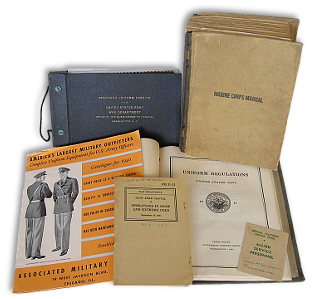 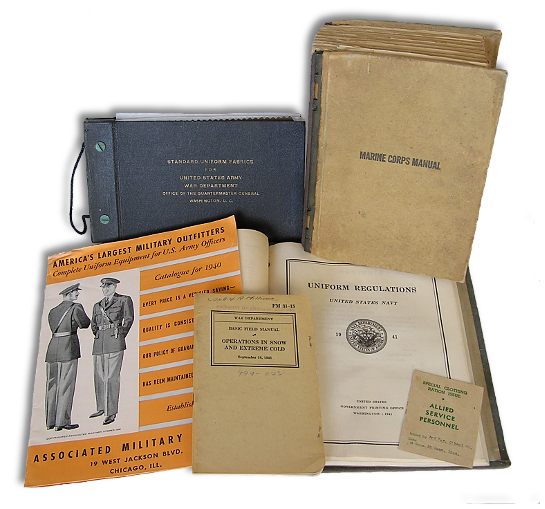 Above: Pictured are a few examples of the types of original source documents that are used in support of this website. Clockwise from 6 o'clock bottom: US Army field manual for cold weather operations dated 1941, Army officers clothing catalog dated 1940, Quartermaster Corps book of fabric samples dated 1941, US Marine Corps Manual dated 1940, US Navy uniform regulations dated 1941, and a coupon book redeemable for new clothing for allied soldiers visiting Australia. Original source documents are instrumental in gaining a more complete understanding of the uniforms of the era. Many of these documents will soon be accessible through the site's bibliography section. Above: Pictured are a few examples of the types of original source documents that are used in support of this website. Clockwise from 6 o'clock bottom: US Army field manual for cold weather operations dated 1941, Army officers clothing catalog dated 1940, Quartermaster Corps book of fabric samples dated 1941, US Marine Corps Manual dated 1940, US Navy uniform regulations dated 1941, and a coupon book redeemable for new clothing for allied soldiers visiting Australia. Original source documents are instrumental in gaining a more complete understanding of the uniforms of the era. Many of these documents will soon be accessible through the site's bibliography section.Above: Pictured are a few examples of the types of original source documents that are used in support of this website. Clockwise from 6 o'clock bottom: US Army field manual for cold weather operations dated 1941, Army officers clothing catalog dated 1940, Quartermaster Corps book of fabric samples dated 1941, US Marine Corps Manual dated 1940, US Navy uniform regulations dated 1941, and a coupon book redeemable for new clothing for allied soldiers visiting Australia. (touch for expanded image) United States Military Uniforms of World War II offers many different features to bring the uniforms of the era to life. The site's main feature and the foundation that it is built upon are its in-depth essays of individual uniform components. These essays make use of multiple photos, text, and links to present as much detailed information as possible for each item. Original uniform items, in excellent condition, are a key element of this website and examples appear frequently throughout its pages. In order to provide a solid basis for identification, these items are presented using a number of different perspectives including full front, back, and side shots. Additionally, close-ups are used to show details of an item's key features and side by side shots are used for the purpose of comparing like items. Period photographs showing uniforms in actual use play an equally important role throughout the site. Not only are original photos used in the individual uniform essays, they are also integral to two of the sites other main features "Photo Essays" and "Slideshows". Original source documents, such as uniform regulations, equipment lists, and catalogs are used in support of the text and can be found included in many of the site's special features. Additionally, for those who wish to engage in further study, some of these documents will be made accessible via direct links on the site's bibliography page. In some cases entire documents may be available, or where larger documents with multiple topics are concerned, only those parts that specifically pertain to uniforms will be included. Other special innovations can be found on this site as well, such as its unique clothing contract databases that provide access to information on thousands of World War II era clothing contracts. All of the various features and sources of information found on this site are designed to be used in combination with one another to provide an effective means to identify uniforms of the period and answer other fundamental questions surrounding their origins, purpose, and use. Information on this site is organized in a logical fashion to make finding what you are looking for quick and easy. There are separate uniform indexes for Army, Navy, Marine, and Army Air Force uniforms where links to essays on specific items can be found. Essays are presented first in a quick to digest format using large pictures and quick reference charts and grids. Then, for those who wish to explore further, a section of more detailed information follows. Here detailed photos are presented along with a comprehensive notes section that discusses the item's background, development, wartime use, special features, and post-war destiny. Links and pop-up images are used throughout the site's various features to help show relationships between items and to provide further explanations and detail. Where blue text appears there is a link to another page, and where red text appears a touch sensitive pop-up box exists to provide a supplemental definition and/or photograph. Most of the photos found on this site will expand to a larger size by pointing to or touching the image. To supplement the individual item essays, an introduction providing an overview of United States uniform development during World War II can be found in the "About" menu. As its content grows, United States Military Uniforms of World War II will continue to undergo changes in the hopes that it can become the finest free source of information available of its kind. Creating an interactive environment where those interested in the subject of World War II uniforms can engage in discussion and share their knowledge is paramount among changes planned for the future. Some immediate goals for improving the website are as follows:
An attempt to put together anything near a complete reference on the uniforms used by US forces during WW2 poses a serious challenge due to the sheer number of items involved. For example, the Philadelphia Quartermaster Depot alone developed over 400 unique clothing issues for use by Army ground forces between December, 1940 and the end of 1945. Though a daunting task, it is intended for this website to tell the story of these uniforms as completely and in as much detail as possible. However, to accomplish this task and cope with the huge quantities of items involved, it is necessary for the site to grow incrementally through the gradual addition of items over time. At the outset it was necessary to limit the site's content to only those uniforms worn by the United States Army, Navy, Marines, and Army Air Force. This measure was taken to put some kind of limit, though in reality a modest one, on the potential number of uniforms that need to be addressed. Though many auxiliary services and independent organizations played an important role in the war, such as the Coast Guard, Merchant Marines, United States Maritime Service, United Sates Army Transportation Corps, Nurses' Corps, etc., to name just a few, the uniforms that they wore are, for the most part, not covered on this site. However, sometimes these organizations made use of the same uniform designs as one of the services featured on this site, and when this is the case, these items may be briefly discussed and examples occasionally shown. The majority of uniforms worn during World War II were manufactured according to a set of government specifications in order to ensure conformity in appearance and set a minimum quality standard. The uniforms exhibited on this site will be of the kind developed by the US government and manufactured according to the regulations and specifications that were set forth for them. These were the most common and familiar uniform types. They were intended for general or special issue and reflected what military clothing developers determined was optimal for their personnel to wear at the time. Whenever possible, clothing examples will be used that have intact, legible government contract labels or markings. The information that these labels and markings provide serve a useful purpose in identifying items and when they were made, thus establishing a basis for the study of previous and latter issues. Clothing worn during the war often originated from a number of other alternative sources, such as trial or experimental programs, supplemental items produced by the Home Front or Red Cross for overseas use, substitute standard items (typically commercial items purchased by local quartermaster procuring agencies as a stopgap measure when items of regular issue were unavailable), and similar avenues. In most cases, clothing items supplied by alternative and supplemental sources will not be covered on this site. It is important to recognize that often times inconsistencies will be found when comparing the information contained in official documents, such as histories, regulations, equipment lists, catalogs, and period photos with the actual physical characteristics of surviving examples of clothing items. There are a number of reasons for this, some of which include the Government's need to use alternative patterns and materials to expedite high production volume, the use of alternative materials in lieu of standard materials that were now being consumed for more urgent uses, and the manufacture of garments for US forces by Allied countries that often made use of special patterns and/or local materials. |
These variables quite often resulted in a great variation of colors, fabric, and construction features for a given item. Wherein such variations represent an important part in the history of a particular item they may be included on this site. Another cause in the deviation of norms was the extreme rapidity with which some items were developed. Some clothing components had an extremely short life - as few as one production run before being redesigned or replaced by a wholly new example. As a result, some items are extremely hard to come by because few examples survived. Due to the short life cycle of some items, often there is little or no information regarding them in period publications. Such examples will sometimes be missing from this site, or when included, be lacking critical information from their historical background.   Above: Two Olive Drab Field Jackets, both procured in the spring of 1942, serve to illustrate how WW2 era garments could differ substantially in appearance from one another. The Jacket on the right was manufactured in olive drab shade 2 cotton poplin as per regulations stated, while the jacket on the left was manufactured in cotton twill in a shade almost khaki in color. The different material types are shown above the jackets for reference. Alternative materials were frequently used in the production of this jacket in order to meet enormous production requirements. Though many of these jackets differed from published specifications and regulations they nevertheless played an important role in their history. Variations were so frequent that there is often confusion and controversy among current collectors as to what the "correct" color of this jacket was. Above: Two Olive Drab Field Jackets, both procured in the spring of 1942, serve to illustrate how WW2 era garments could differ substantially in appearance from one another. The Jacket on the right was manufactured in olive drab shade 2 cotton poplin as per regulations stated, while the jacket on the left was manufactured in cotton twill in a shade almost khaki in color. The different material types are shown above the jackets for reference. Alternative materials were frequently used in the production of this jacket in order to meet enormous production requirements. Though many of these jackets differed from published specifications and regulations they nevertheless played an important role in their history. Variations were so frequent that there is often confusion and controversy among current collectors as to what the "correct" color of this jacket was. Above: Two Olive Drab Field Jackets, both procured in the spring of 1942, serve to illustrate how WW2 era garments could, contrary to published regulations, differ substantially in appearance from one another. The Jacket on the right was manufactured in olive drab shade 2 cotton poplin as per regulations stated, while the jacket on the left was manufactured in cotton twill in a shade very nearly khaki in color. (touch for expanded image) The size and scope of World War II required not only a great expansion of US forces but also its transformation into one capable of global operations. Outfitting this multi-million man global force created a uniquely rich period in US military uniform history that was punctuated by the application of scientific and technical methodology to clothing development, continual improvement in designs, and the creation of a tremendous amount of variety. While much is known about uniforms of the period, the enormity of war-time events has left behind a fertile ground for continued exploration and learning. After years of collecting and studying World War II uniforms, I am still learning new things and discovering new items, and I am quite certain this will always be the case. In the same vein, this website should be viewed, not as a rigid, authoritarian work, but as a ongoing project; one that is continually adding new information as it grows, and one that can be corrected when need be. The humble beginnings of United States Military Uniforms of World War II are rooted in an HTML class I took at my local community college in the summer of 2011. The idea for the site began simply as a desire to take the technical subject I was studying at the time and apply it to a topic of interest in the hopes of making my learning experience more stimulating and pleasurable. After working on the prototype website awhile, I started to think of all the different ways that the web could be used to bring the history of these uniforms to life, and that just maybe such a site could be useful and interesting to people. My experiment turned out to be my final project for the class, and after some encouraging words from my teacher, family, and fellow students the site was on its way. Since then, despite some ups and downs, it has, more or less, kept growing and evolving ever since. 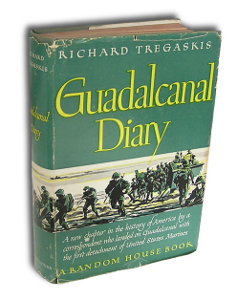  Above: The book that ignited my interest in the Second World War - Richard Tregaskis' Guadalcanal Diary was an early firsthand account of Marine operations on the South Pacific island of Guadalcanal. Above: The book that ignited my interest in the Second World War - Richard Tregaskis' Guadalcanal Diary was an early firsthand account of Marine operations on the South Pacific island of Guadalcanal.Above: The book that ignited my interest in the Second World War - Richard Tregaskis' Guadalcanal Diary was an early firsthand account of Marine operations on the South Pacific island of Guadalcanal. (touch for expanded image) My interest in WW2 began as a young boy after reading the classic 1943 book Guadalcanal Diary by Richard Tregaskis. Its vivid firsthand accounts of the bravery and courage displayed by US Marines during the early fighting against the Japanese on the South Pacific island of Guadalcanal left quite an impression on me. The book also clearly brought home the hardships, depravations, and sacrifices that our servicemen endure when fighting for America's freedoms. Tregaskis' book made such an impact on me that I had to know more. I told my father about what I had read and asked him what he knew about the war? what it had been about? and why the fighting was necessary? In the course of his answering my questions I was astonished to learn that my father, Charles, unbeknownst to me, had also served in the US Army during World War II. Much more reading followed, as well as a life-time of questions for my father about his experiences during the War. Reading about World War II as a youngster was often both captivating and frightening at the same time. Pages were filled with amazing tales of courage, perseverance, and humanity set against the dark, fury of an all-consuming war. Needless to say, I quickly became fascinated by all things World War II; an interest that has remained with me throughout my life. 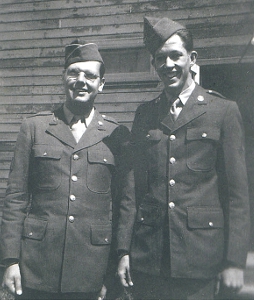 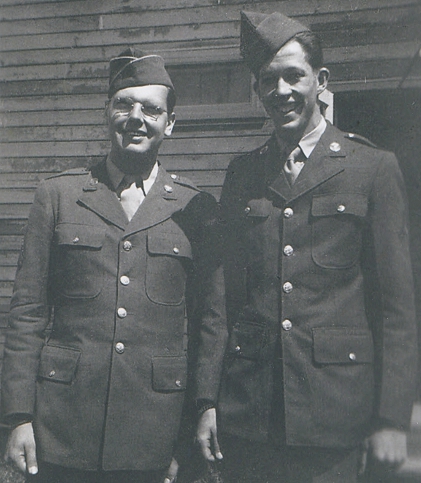 Above, standing to the left: My father, Charles Reuscher, as a member of the US Army's 98th Field Hospital poses with a buddy in Japan during 1945. Above, standing to the left: My father, Charles Reuscher, as a member of the US Army's 98th Field Hospital poses with a buddy in Japan during 1945.Above, standing to the left: My father, Charles Reuscher, as a member of the US Army's 98th Field Hospital poses with a buddy in Japan during 1945. (touch for expanded image) I first encountered military uniforms not long after my interest in World War II began. Curiosity led me to venture into one of the many army surplus stores that existed in my home town of Chicago back in the 1970's. Once inside, the racks of used uniforms caught my attention and made me wonder what story each of them had to tell - who had worn them? where had they been? what had they been through? Moreover, I couldn't help but notice that each type of uniform possessed its own unique design characteristics and features consisting of color, style, material, and insignia; all clues that could reveal a uniform's past if only I could learn how to interpret them. Shortly thereafter I began to collect and study uniforms and soon found many other sources to acquire them, such as thrift stores, flea markets, antique malls, and militaria dealers. Collecting uniforms became a natural and rewarding extension of my interest in World War II. Doing so allowed me to interact with the past in an intimate and tangible way. Now I could see history, hold it in my hands, and even be its caretaker. It brought a vivid, three-dimensional life to history by providing color, depth, and immediacy to long ago events that had been largely captured in black and white images. Collecting and preserving uniforms that once belonged to real people who selflessly served our country during a time of such great need brings a feeling that is both humbling and rewarding. Ultimately it is hoped that by preserving and displaying these uniforms curiosity will be aroused in future generations to learn more about the men and women who wore them, the events they're associated with, and even about how and why they were created. 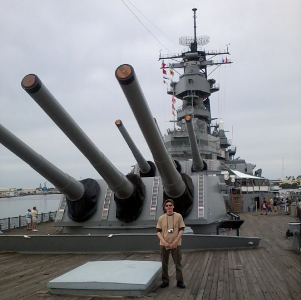 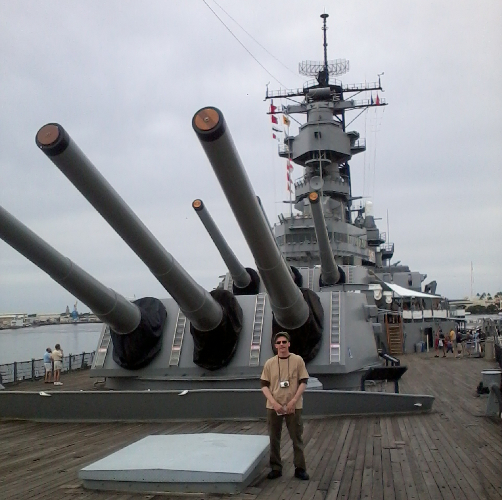 Above: After developing a life-long interest in World War II as a young boy, a dream was finally realized in 2011 when I was able to visit the Pearl Harbor Memorial in Hawaii. Here I am aboard the USS Missouri - dwarfed by its big guns and humbled by the experience. Above: After developing a life-long interest in World War II as a young boy, a dream was finally realized in 2011 when I was able to visit the Pearl Harbor Memorial in Hawaii. Here I am aboard the USS Missouri - dwarfed by its big guns and humbled by the experience. Above: After developing a life-long interest in World War II as a young boy, a dream was finally realized in 2011 when I was able to visit the Pearl Harbor Memorial in Hawaii. Here I am aboard the USS Missouri - dwarfed by its big guns and humbled by the experience. (touch for expanded image) Learning how to correctly identify uniforms and getting to know their history was a gradual process that took many years of study and a lot of patience. Early on, it involved comparing the uniforms I found with photos shown in history books and reading any books I could find on the subject. Then later, it involved diligently noting information found on contract labels as well as examining garments for any changes in design and then connecting this information together to track an item's developmental history. It wasn't until the 1990's and the internet revolution, though, that the greatest learning opportunity of all occurred. Thanks to the internet large quantities of material became readily available at one's fingertips that made comparing and piecing together the histories of these items significantly easier. It was now possible to look at hundreds of different uniforms that appeared each week on various online auction sites, which in effect eliminated the tedious physical task of having to track down items one by one. It is now my mission to channel the knowledge, experience, and passion I've built up over the years for World War II uniforms into the creation of a dynamic place where their story can fully come to life.
I would like to extend a heartfelt thanks to all that have assisted with United States Military Uniforms of World War II. Those who have been kind enough to contribute uniform samples, design ideas, assisted with proofreading, and the like, have all been invaluable to its success. A special thanks to Laura, my wife, who without her ideas, suggestions, words of encouragement, and general support I could have never undertaken this project. And to all who have taken the time to send a kind word - it is your thoughtfulness that inspires me to keep this site going!
|